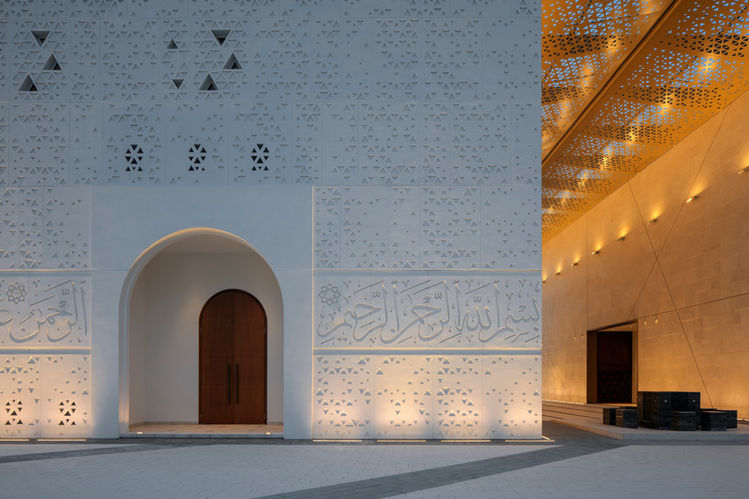
© Gerry O’Leary
PROJECT DETAILS:
KNOW MORE ABOUT THE DESIGNERS:
Creating a transition from the outer material world to an inner sense of being
As a gift to the community, and in honour of the late patriarch of the family, Mohamed Abdulkhaliq Gargash, the Gargash family’s brief was to create a minimal contemporary mosque, a calm and spiritual space for prayer, for the community of the Al Quoz, the industrial heart of Dubai. Committed to supporting local industries, and in keeping with the practice’s sustainable approach to design, Dabbagh Architects sourced materials from the mosque’s locality: stone from Oman; concrete, aluminium, cladding, joinery, and ceramics from the UAE.
At the heart of the design approach is the enhancement of the act of worship, and a transitional journey throughout the building so that the worshiper is ready for prayer and feels a sense of intimacy with the sacred.
Light as a tool to create a connection with the divine
Natural light is used as a tool to enhance a feeling of spirituality, the connection between the earthly and the divine, and to mark the worshiper’s journey through the building. Scale also plays a role in creating this sense of sacredness.
Starting at the mosque’s outdoor entrance, perforated shading creates a threshold of perforated light that leads the worshiper to the ablution area, where physical cleansing invites the clearing of the mind and preparation for prayer. The route continues through to a lobby space, where further shedding of the material world takes place through the act of removing one’s shoes.
Once inside the prayer hall, the visitor further transitions to a contained space where reading from the Quran may take place before prayer. All the while, the quality of light from one space to another changes to enhance the preparation process so that when the worshiper finally enters the main hall, they are ready for prayer.
Pared down form eschews traditional architectural typology
By simplifying the traditional typology of the Islamic form, and stripping it away to its essence, Dabbagh Architects sought to avoid multiple blocks. In the process of design development, the main building volume was separated into two: firstly, the prayer block containing the male and female prayer areas, and secondly, the service block where the ablution facilities and residence for the Imam (the leader of prayer) and Moazen (caller of prayer) are found.
As a result of this division, a courtyard is formed, with has a sculptural canopy reaching out to reconnect the two volumes together. With its two arms almost touching, the canopy gives a sense of separation of the functional and the more scared: the practicality of the ablution ritual and the spirituality of prayer. In further contrast to traditional mosque architecture, the minaret is designed as a separate volume.
A reinterpretation of Islamic geometry and metaphorically protective calligraphy
The use of pattern and materiality in this project enhances the user’s experience as they journey from the outside into the courtyard and enter the building. Throughout the building, a triangular pattern gives reference to traditional Islamic geometry, but reinterpreted in a deconstructed contemporary language.
The exterior paneling uses this triangulated pattern in recessed and perforated elements, which gives the building’s skin a dynamic appearance. Internally, these perforations scatter natural light into the areas of worship with great control and care to illuminate the key spaces, and to create a calm atmosphere and sense of connection to the divine, as well as helping to cool the mosque’s interior. The double skin dome also allows natural light to enter, filtering it through the internal decorative skin, which incorporates the same triangulated pattern as the rest of the building. This filtered light creates a soft, naturally-lit prayer space tailored to the introspective mind during prayer. The reinterpreted Islamic patterns and triangulated geometry harmonize throughout the interior as lines intersecting across walls, carpets, and light fittings.
Calligraphy plays an important part in the overall design. A Surah (verse from the Quran) wraps around the prayer hall externally to create a metaphoric protective band, signaling the spiritual nature of the space upon arrival and instilling a sacred energy throughout the building. The verse, “The Most Merciful”, is composed entirely in saj’, the rhyming, accent-based prose characteristic of early Arabic poetry, and references the sun, the moon, the stars and heavens and many other creations.
GALLERY:









